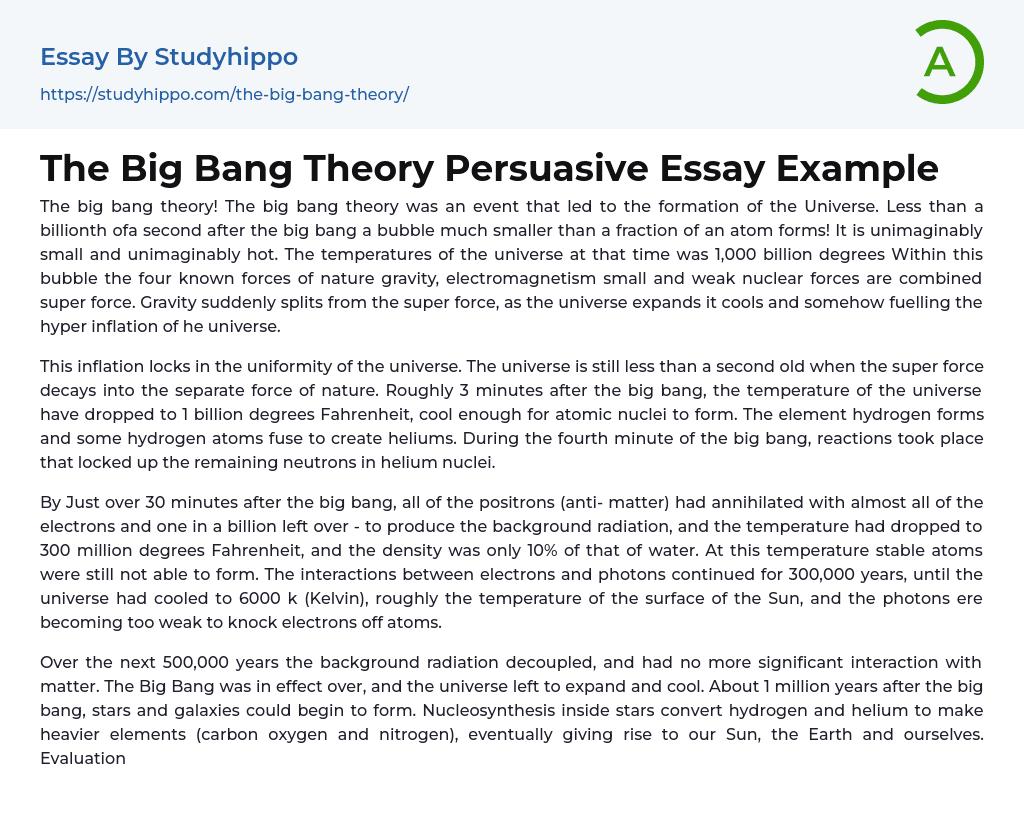The big bang theory! The big bang theory was an event that led to the formation of the Universe. Less than a billionth ofa second after the big bang a bubble much smaller than a fraction of an atom forms! It is unimaginably small and unimaginably hot. The temperatures of the universe at that time was 1,000 billion degrees Within this bubble the four known forces of nature gravity, electromagnetism small and weak nuclear forces are combined super force. Gravity suddenly splits from the super force, as the universe expands it cools and somehow fuelling the hyper inflation of he universe.
This inflation locks in the uniformity of the universe. The universe is still less than a second old when the super force decays into the separate force of nature. Roughly 3 minutes after the big bang
..., the temperature of the universe have dropped to 1 billion degrees Fahrenheit, cool enough for atomic nuclei to form. The element hydrogen forms and some hydrogen atoms fuse to create heliums. During the fourth minute of the big bang, reactions took place that locked up the remaining neutrons in helium nuclei.
By Just over 30 minutes after the big bang, all of the positrons (anti- matter) had annihilated with almost all of the electrons and one in a billion left over - to produce the background radiation, and the temperature had dropped to 300 million degrees Fahrenheit, and the density was only 10% of that of water. At this temperature stable atoms were still not able to form. The interactions between electrons and photons continued for 300,000 years, until the universe had cooled to 6000 k (Kelvin)
roughly the temperature of the surface of the Sun, and the photons ere becoming too weak to knock electrons off atoms.
Over the next 500,000 years the background radiation decoupled, and had no more significant interaction with matter. The Big Bang was in effect over, and the universe left to expand and cool. About 1 million years after the big bang, stars and galaxies could begin to form. Nucleosynthesis inside stars convert hydrogen and helium to make heavier elements (carbon oxygen and nitrogen), eventually giving rise to our Sun, the Earth and ourselves. Evaluation
- Solar System essays
- Atom essays
- Big Bang Theory essays
- Density essays
- Electricity essays
- Energy essays
- Force essays
- Heat essays
- Light essays
- Motion essays
- Nuclear Power essays
- Physiology essays
- Sound essays
- Speed essays
- Temperature essays
- Thermodynamics essays
- Electron essays
- Experiment essays
- Explorer essays
- Hypothesis essays
- Observation essays
- Qualitative Research essays
- Research Methods essays
- Theory essays
- Agriculture essays
- Albert einstein essays
- Animals essays
- Archaeology essays
- Bear essays
- Biology essays
- Birds essays
- Butterfly essays
- Cat essays
- Charles Darwin essays
- Chemistry essays
- Dinosaur essays
- Discovery essays
- Dolphin essays
- Elephant essays
- Eli Whitney essays
- Environmental Science essays
- Evolution essays
- Fish essays
- Genetics essays
- Horse essays
- Human Evolution essays
- Isaac Newton essays
- Journal essays
- Linguistics essays
- Lion essays




